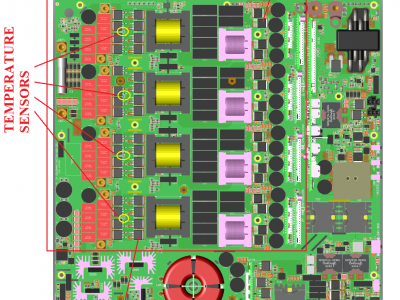Power and Energy

The evolution of the power grid is progressively shifting towards a much more dynamic and complex system. Generation sources that are more decentralized and reliant on inverter-based technologies, plus increasing demand for electrification of new types of loads are introducing more challenges to grid stability. Grid operators must adapt, requiring more extensive, granular, and timely data to enable analytics for improved efficiency and development of proactive mitigation strategies.
- Categories:
 265 Views
265 ViewsThis dataset was used for the capacity planing of ahybrid solar PV-small hydro power plant located in Buseruka, Hoima District in Uganda. The data consitss of four files namely:
1. 20240601_GenerationStatisticsQ1_2024-Kabalega-Hydromax: Represents power generation statistics from ERA for Kabalega/HYdromax HPP.
2. Hydrology from Buseruka HPP - 2015-2022: Represents the hydrology or river flow data in cumecs for the period 2015 to 2022 as provided by the plant operators.
- Categories:
 202 Views
202 Views
Health degradation issues in automotive power electronics converter systems (PECs) arise due to repetitive thermomechanical stress experienced during real-world vehicle operation. This stress, caused by heat generated during semiconductor operation within PECs, leads to the degradation of semiconductor's operating life. Estimating the power semiconductor junction temperature (Tj) is crucial for assessing semiconductor degradation in operation. Although physics-of-failure-based models can estimate Tj, they require substantial computational power.
- Categories:
 400 Views
400 Views
This dataset is shared for capacitor C and ESR estimation using convolution neural network. The dataset is collected in a experimental modular moultilevel converter, which includes the capacitor voltage at low and medium frequency band, and the arm current. Wavelet transform is used to transfer the time series data to images, which present the inherent data features to image patterns. In a degraded capacitor, the C decreases and the ESR increases, which result in different image patterns.
- Categories:
 324 Views
324 ViewsNormal 0 false false false EN-US X-NONE X-NONE /* Style Definitions */ table.MsoNormalTable {mso-style-name:"Table Normal"; mso-tstyle-rowband-size:0; mso-tstyle-colband-size:0; mso-style-noshow:yes; mso-style-priority:99; mso-style-parent:""; mso-padding-alt:0in 5.4pt 0in 5.4pt; mso-para-margin-top:0in; mso-para-margin-right:0in; mso-para-margin-bottom:8.0pt; mso-para-margin-left:0in; line-height:107%; mso-pagination:widow-orphan; font-size:11.0pt; font-family:"Aptos",sans-serif; mso-ascii-font-family:Aptos; mso-ascii-theme-font:minor-latin; mso-hansi-font-family:Aptos; mso-hansi-theme-fon
- Categories:
 238 Views
238 ViewsThis research presents a multi-channel phase shift inductor-inductor-capacitor (LLC) resonant converter with a wide input and output voltage range that has been specially optimized for fuel cell applications. The worst-case minimum stack voltage and the battery voltage range were used to determine the optimal parameters of the LLC converter. The voltage gain of the converter operating at a constant power was considered, and an algorithm for such a calculation is proposed.
- Categories:
 218 Views
218 ViewsArc faults are a significant cause of failure in photovoltaic (PV) system and can arise due to component deterioration, installation problems, rodents chewing on wires, abrasion of insulation, or other root causes. Undetected, incipient arc faults can propagate into electrical fires. Consequently, arc-fault detectors, now mandated in many jurisdictions, are essential for safe operation of PV systems.
- Categories:
 644 Views
644 Views
This letter proposes a virtual slack bus Newton-Raphson power flow (VSB-NRPF) algorithm serving for the PF analysis of droop-controlled medium-voltage direct current (MVDC) systems operating in islanded mode without a slack bus. In the proposed algorithm, one of the original power, current, power/voltage and current/voltage buses is assumed to be a virtual slack bus with an initial rated dc voltage, the value of which is corrected based on the actual PF balance equation at the original bus.
- Categories:
 17 Views
17 ViewsThis repository contains datasets and code with a novel numerical approach aimed at finding a distribution network expansion plan (DNEP) that prevents future congestion and voltage issues. This approach is tested using the modified IEEE 33-bus network. Electricity demand and PV production data for a leap year with a 1-minute resolution was generated using the CREST model from the Loughborough University and is provided as a dataset of future high-load and high-production scenario.
- Categories:
 271 Views
271 ViewsNowadays, decentralized organization has become the emerging characteristic for AC-DC hybrid distribution systems (DS) facilitated by modern power electronic and information & communication techniques. This urges the DS to drop the centralized power supplying mode. In substitution, the DS is divided and operated as several self-adequacy subnetworks. In this paper, a two-stage Wasserstein distributionally robust optimization (WDRO) framework is proposed to provide a dynamic regionalization strategy for unbalanced AC-DC hybrid DSs.
- Categories:
 298 Views
298 Views



